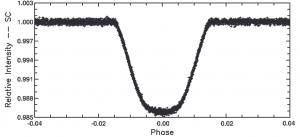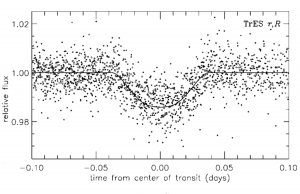Space telescopes like CoRoT, Kepler and PLATO use the transit method to search for exoplanets. Why does it have so many benefits to use space telescopes to search for exoplanets?
It is the lack of an observing disturbing atmosphere and the independence of day and weather.
Figure 1:


The transit method is also used from Earth to search for exoplanets (e.g. TrES, OGLE, WASP, SuperWASP). However due to the disturbing atmosphere the resolution of the light curves is only sufficient to discover large Jupiter-like gas giants. Figure 1 shows a phase stacked light curve with the transit of the Jupiter-sized planet TrES-2b orbiting the star on a 2.47-day orbit. This light curve was monitored with a ground based telescope. The Transit with a depth of 1% is clearly identified. However, it is obvious that the resolution is not sufficient to detect the transit of an Earth-like planet with a hundredth of that depth.

The figure above shows the same transit this time monitored with the Kepler space telescope. Without an atmosphere the noise of the light curve is reduced by a factor of 100. This resolution is sufficient to detect Earth-like planets. The high resolution is also useful to study variabilities of stars. Therefore, these space telescopes are also used to study stellar pulsation, star spots and outbreaks of various stars.

To search for exoplanets, one or more telescopes with large field of view are used. Large star Fields including 10000-100000 stars can be observed simultaneously using CCD cameras in the optical (or near infrared). Images are taken in seconds or minutes intervals regardless of day / night change or weather. Then the light curves of individual stars are generated from these images by using masks. These light curves are filtered using computer algorithms and automatically searched for transits. The planet candidates found in this manner are then usually observed with ground-based telescopes, to fully characterize the planet.
Two dedicated space telescopes were started to search for extrasolar planets (CoRoT and Kepler). Often 20 years pass from the first idea to the start of a space mission. CoRoT was planned as a French mission of CNES for seismic exploration of stars. After the discovery of the first exoplanet in 1995, the concept involving ESA and institutions of other states has been extended to the search for extrasolar planets. Thus, Europe has launched the first space telescope to search for extrasolar planets. Three German institutions were involved in this mission:
- DLR Berlin, Institut für Planetenforschung
- Thüringer Landessternwarte Tautenburg
- Rheinisches Institut für Umweltforschung, Abteilung Planetenforschung an der Universität zu Köln (RIU-PF)
Beside a countless number of planetary candidates and 35 confirmed planets CoRoT discovered the first rocky planet (CoRoT-7b). Unfortunately, the telescope went out of service at the end of 2012 due to a technical failure.
2009 NASA launched the space telescope KEPLER which was dedicated for the search of exoplanets.
This space telescope larger than CoRoT has discovered a large number of exoplanets. Also, the RIU-PF has processed the publicly available Kepler data. We were able to confirm most of the discoveries and have discovered a large number of additional planets. Unfortunately, also the Kepler telescope experienced a technical failure in 2013. In 2014 the mission now called K2 was resumed using a different observing strategy. Currently K2 is the only active space telescope dedicated for the search of exoplanets. RIU-PF is searching for exoplanets in K2 light curves as part of the KEST collaboration.
Through the success of these two telescopes other missions are planned for the future:
- CHEOPS
CHEOPS is the first S-class mission (small) from ESA to be launched in 2017. The telescope will be mainly used to determine the radii of exoplanets from light curves that have been discovered before with the RV method. - TESS
Der „Transiting Exoplanet Survey Satellite“ (TESS) ist eine neue NASA Mission dessen Start für 2017 vorgesehen ist. Mit vier auf dem Satelliten montierten Teleskopen sollen im Verlauf der Mission 500000 Sterne beobachtet werden. Im Gegensatz zur Kepler Mission kann die NASA dieses Mal hellere Sterne auswählen um eine bessere Charakterisierung der Transits und die Nachbeobachtung mit bodengestützten Teleskopen für alle Exoplanetenkandidaten zu ermöglichen. Gleichzeitig soll TESS Ziele für das James Webb Space Teleskop (JWST) auswählen. - JWST
The James Webb Space Telescope (launch 2018) is the official successor of the Hubble Space Telescope and will be equipped with a 6.5 m main mirror. The telescope will observe in the near and mid-infrared spectra and will be also equipped with a powerful spectrograph. The telescope has been developed under the direction of NASA in cooperation with other States as well as the ESA. The development and maintenance of this powerful telescope is expected to cost $ 8.8 billion (JWST Advisory Committee April 2014). This powerful telescope is used for many different astrophysical objectives. Part of the available observation time however is dedicated to the search and observation of exoplanets. - PLATO
PLATO („Planetary Transits and Oscillations of stars“) ist ein geplantes Weltraumteleskop der ESA zur Suche nach Exoplaneten, welches als M-Klasse Mission (medium) im Februar 2014 ausgewählt worden ist. Es steht unter der Leitung von Heike Rauer vom Institut für Planetenforschung des DLR Berlin. Auch das Rheinische Institut für Umweltforschung, Abteilung Planetenforschung ist an der Mission beteiligt.
The launch of PLATO is planned for 2022-2024.